A CLOSE LOOK AT FLINT PATINA
By Robert Bingham
Texas Cache Magazine 2025
For archaeologists and artifact enthusiasts alike “flint patina” has come to be be defined as “the distinct change in the surface
appearance of an ancient flint artifact created by long-term weathering.” A sometimes subtle transformation that at other
times can cause stunning alterations in color and luster coupled with a beautiful polishing of a once buried artifact’s entire
surface.
When closely studied we see that flint patination is an ongoing chemical process that over time turns many examples frosty blue then white while simultaneously smoothing broader surfaces and increasing their reflective sheen. This transformation can appear as a solid color and other times it looks streaky and spotted like rain cascading across your windshield.
Could it have something to do with water?

(Above) A 4" long Fredericksburg point from the collection of the author with a nice example of bleached microfossils in the patina.
(Below) Close-up photos of the microfossils on the point.
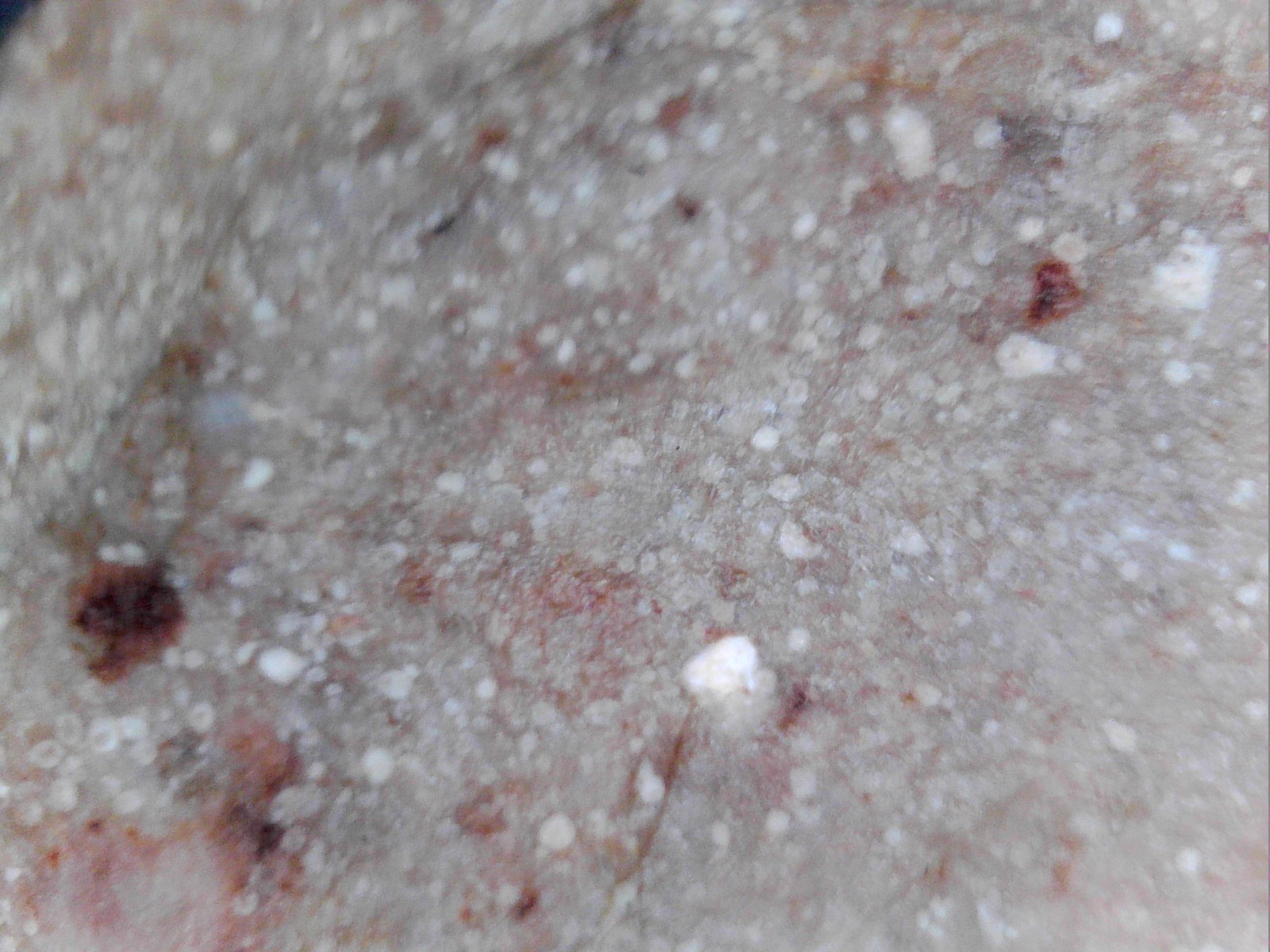
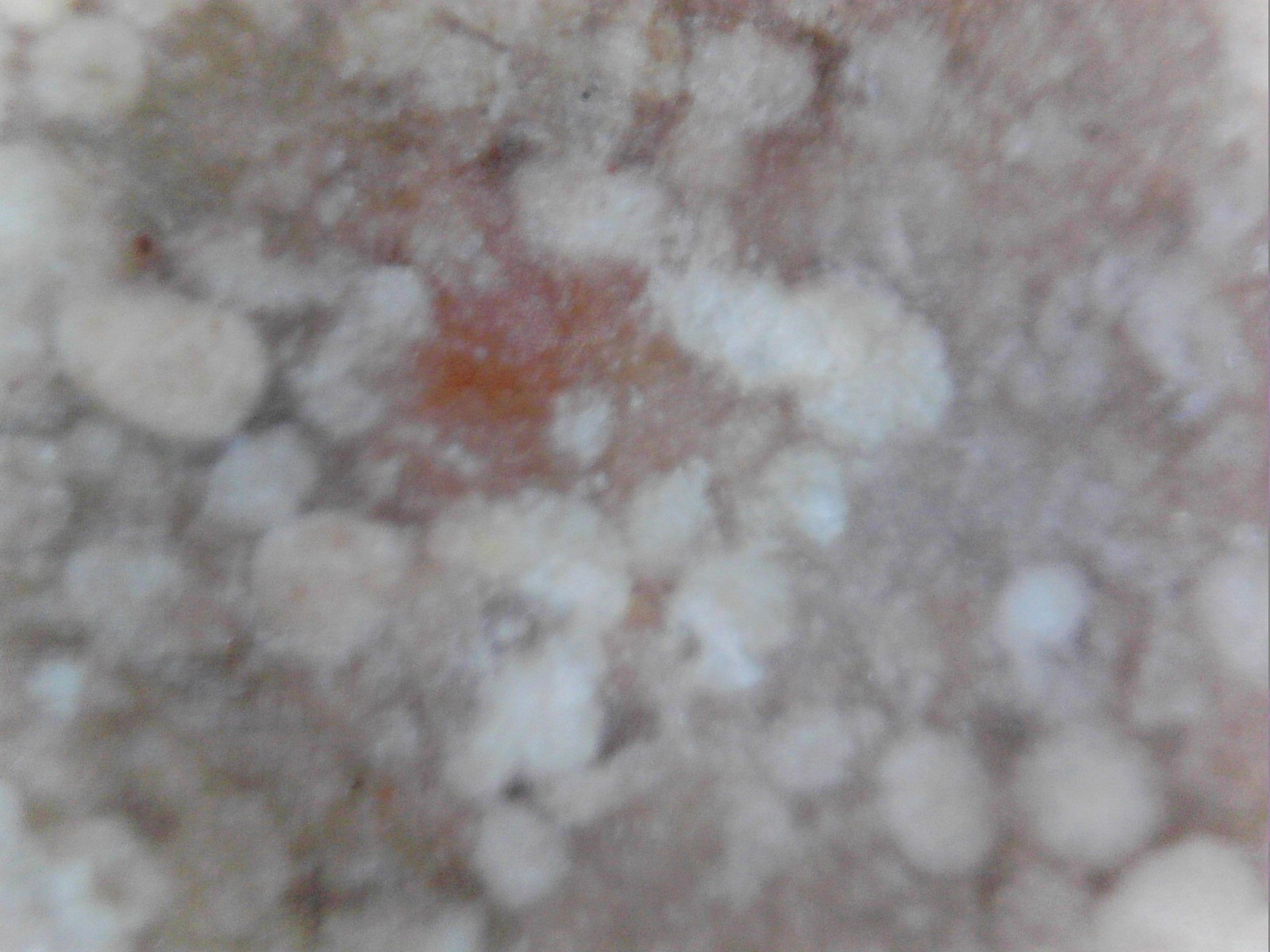
But first.., what exactly is flint?
‘Flint’ or what is also sometimes called ‘Chert’ is geologically
classified as a cryptocrystalline (“hidden crystal”) quartz
which simply means that it is mostly composed of microscopic
silicon dioxide (SiO2) crystals too small to see with the naked
eye. But upon closer analysis we see that flint's internal
structure is actually a complex mixture of three very different
minerals: crystalline silica (chalcedony), amorphous silica (opal)
and calcium carbonate (calcite).
Chalcedony is thought to precipitate directly from ancient silica rich sea water and has a fibrous texture that is slightly porous and mostly insoluble in water at room temperature. Opal in contrast lacks any crystal structure, contains up to 21% water, and is primarily composed of the fossilized skeletons of ancient plants known as diatoms and the spicules of corals which both prove to be fairly soluble when it comes to chemical weathering. These two types of quartz in turn provide a matrix for the suspended remains of crinoids, corals, and sea shell fragments all composed of calcite.
Flint thus contains a small percentage of water and is surprisingly permeable when exposed to subsurface aqueous solutions. This internal water content also helps to explain why flint cracks and pops when overheated and why some recently dug artifacts appear to develop instant patina right after they’re exposed to the air and allowed to dry. Plus flint has been a tried-and-true lithic source for the manufacturing of stone tools since the very dawn of early mankind for three very important reasons: first it is hard (7 on Mohs hardness scale of 10), second it is readily available in abundant occurrence along the Edwards Plateau here in Central Texas, and third it is brittle enough to be flaked in a predictable way that leaves a sharp durable edge.
Next let’s focus our attention on the specific lithic material we have to work with in Central Texas: “.., the Edwards Group occur in a variety of nodular and bedded forms, and on the whole, are highly variable in appearance. The heterogeneous nature of the material has led to the generalization of the term “Edwards chert“ to represent any gray or tan chert found in West Texas and the Southern plains (Frederick and Ringstaff 1994; Tunnell 1978; Hoftman et al. 1991) and has encouraged the discovery of a simple, expedient means of identification. [But] At this time there is no single reliable means of identifying Edwards chert.” (Ref 1)
Now while keeping all of these facts in mind how do we best begin a detailed study of ‘flint patination’? To organize this scientific endeavor most modern researchers have chosen to classify flint patina into four main categories:
(1) Mineral deposits
(2) White Patina
(3) Gloss Patina
(4) Dark (or Stain) Patina.
Mineral Deposits
These external deposits commonly occur as a rough flaky crust similar to the calcium deposits found in water pipes. Local diggers often call it “caliche” and some collectors choose to leave it on for authentication purposes while others simply remove it with water and a toothbrush. Its buildup on a flint artifact is often traceable to limestone impregnated soil layers and likely determined by just how much calcium carbonate saturated ground water actually makes contact with an artifact over a very long period of time.
White Patina
“White patinas, as the name implies, are bluish white, white or light gray in color, often have a splotchy or mottled appearance, and are, in general, are less transparent and generally of a lighter color than the core of the artifact (VanNest 1985; Schmalz 1960; Hurst and Kelly 1961” [Ref 2]
Bleaching by prolonged exposure to sunlight is often the first explanation many of us are given for white patina formation. But what self-respecting Native American wouldn’t have naturally picked up and reused a well-made stone tool if it was just lying around out there in the open? In modern practical experiments where flint was subjected to long exposures and high doses of both infrared light and natural sunlight it only resulted in a slight graying of some flint surfaces tested. And even more specifically that: “UV discoloration is moderate even after one year of [full sunlight] exposure... Moreover, the discoloration [whitening] we observe is not comparable (on an experimental scale) to the strong patina often visible on archaeological material..." (Ref 3)
In contrast it was renowned American archaeologist Neil Judd who first suggested in 1887 that “Carbonate-bearing ground-water leached the more soluble amorphous silica, leaving minute interstitial (in between) cavities in the altered margin of the flint. The multitudes of surfaces thus produced reflect and refract light falling upon or passing through the flint, and the resulting scattering causes the white appearance of the altered
portion.” [Ref 4] This process occurs under the influence of an aqueous solution of carbon-dioxide saturated rain water (a weak carbonic acid) which chemically releases internal water and simultaneously allows aqueous silica to migrate toward the surface.
Gloss Patina:
“For [Gloss] patination the most important process is the dissolution and reprecipitation of silica in the form of a thin film or rind. [While this] Patination depends on many factors such as the pH of the environment, soil characteristics (porosity, permeability, soil texture, chemistry, mineralogy ...), circulating groundwater, temperature, duration of exposure, the structure of the flint material and even plant
root growth” (Burroni et al., 2002; Glauberman and Thorson, 2012; Hurst and Kelly, 1961; Rottländer, 1975; Schmalz, 1960; Stapert, 1976). [Ref. 5]
Modern American archaeologist Calvin Howard further clarifies that “Gloss patina is also distinct from desilication** (white) patina and stain patina. (Though) In fact all three of these natural surface modifications can be present on the same artifact. Gloss patina on artifacts may be present in various stages of development ranging from initial incipient stages difficult to detect got advanced stages obvious to the unaided eye...Artifacts with advanced gloss patina have a true glossy texture and feel pleasantly smooth to the touch. Virtually all flint artifacts that have been exposed to soil water solutions for extended periods have some stage of gloss patina.” [Ref 6]
Viewed under the microscope gloss patina first appears as a transparent waxiness, then as a dimpled latticework with a bluish tint, and ultimately results in a pearly white reflective layer that completely inundates and obscures the original surface. In other words, flint artifacts can become coated with an opalized film that in its early stages casts a bluish tint but later becomes increasingly opaque white as it thickens and matures.
Furthermore, another defining characteristic of early gloss patina formation is: “When the surface is bleached, distinct features in
the flint are highlighted and better visible against the matrix.” [Ref 7] This includes an abundance of microfossils which are typically bleached bright white before they are blurred and obscured by the ongoing surface build up of redeposited silica (See microphotos #1 and #2 showing early stages ). This is the same kind of reaction to calcite here in Central Texas allows the eventual carving out of immense underground Karst cave formations.
Stain or Dark Patina
Lastly, there is a darkening and browning (and even) blackening of flint artifacts that sometimes occurs as a ‘river patina’ from being long immersed in either iron or organic material rich rivers and hot-springs environments. But in the specific case of Edwards chert this staining process is mostly accomplished by the slow dissolving and diffusion of micro-granular impurities: A conclusion that the Fort Hood study supports by stating: “The color changes produced during (flint) patination relate to changes in texture and impurity content occasioned by the attack of weathering agents on impurities in the flint.” [Ref 8 ] This simply means that tiny particles mostly of iron, barium, and aluminum are caught up in the flow of aqueous silica and begin to oxidize, dissolve and trickle across the artifact’s surface. [See iron particles dissolving in microphoto #4].
In addition, elemental testing by Instrumental Neutron Activation of a wide range of Edwards Plateau flint samples found here in Central Texas determined that: “With respect to the parent material influence on the patination process, Edwards Group chert is more heterogeneous in appearance than most other cryptocrystalline silicates and therefore the properties influencing patination are more variable as well." [Ref 9] In addition the Fort Hood study also concluded that: “It is possible that edaphic [soil] environments exhibiting a wider range of pH or a more uniform alkaline environment may indeed influence the patination process, but within the examined [Edwards chert] population soil pH appears to have no influence on the observed degree of patination.” [Ref 10]
So despite there being only a handful of well understood processes by which white gloss patina actually forms and builds up on an artifact as it lies buried underground there are a myriad of external factors that also affect at just what rate and to what extent that patination will actually occur.
Which simply means that no matter how much frosty white patina might show up on your favorite artifact, this kind of opalization can easily appear on any well-weathered piece of flint from a historical arrowhead all the way to the very earliest of Clovis points. And finally because of flint patination's complexity and Edward Plateau Flint's variability even within the context of a well-documented single site collection, gloss/white patina by itself [although beautiful] at least for now remains a poor indicator of chronological age.
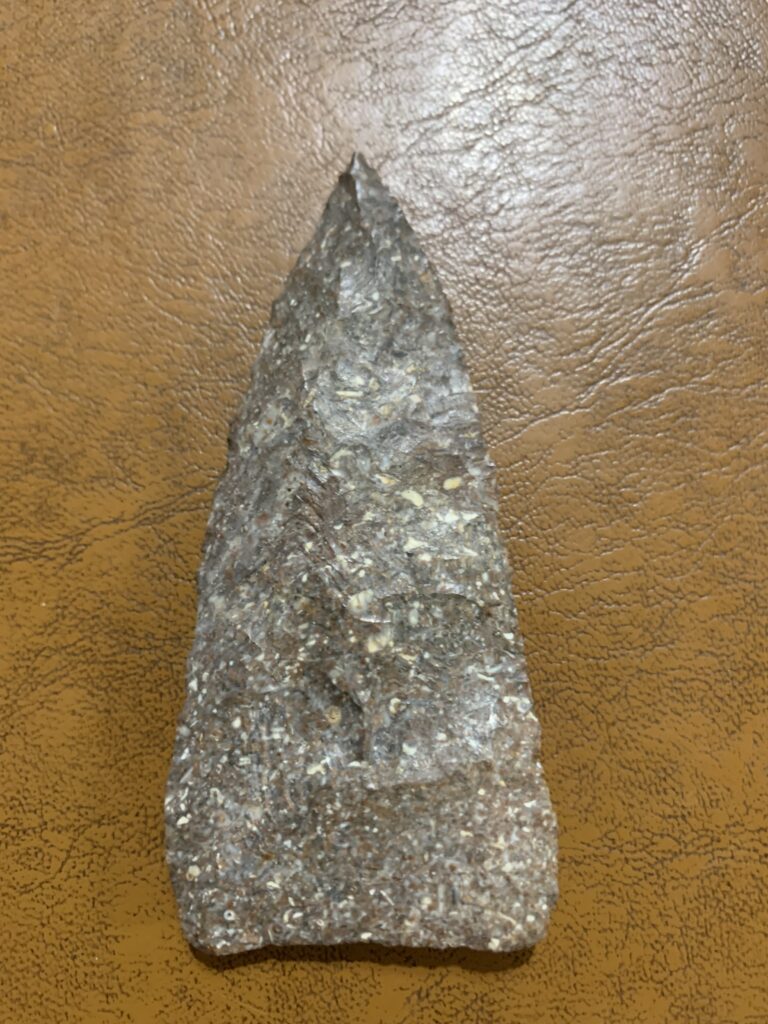

This 3 1/4" Texas blade is a wonderful example of how fossil inclusions are bleached and highlighted in the beginning stages of gloss patina formation.

Above: Microphoto #1 showing highlighted fossils.

Above: Microphoto #2 showing highlighted fossils.

Above: Microphoto #3 showing impurities beginning to dissolve in aqueous silica flow.
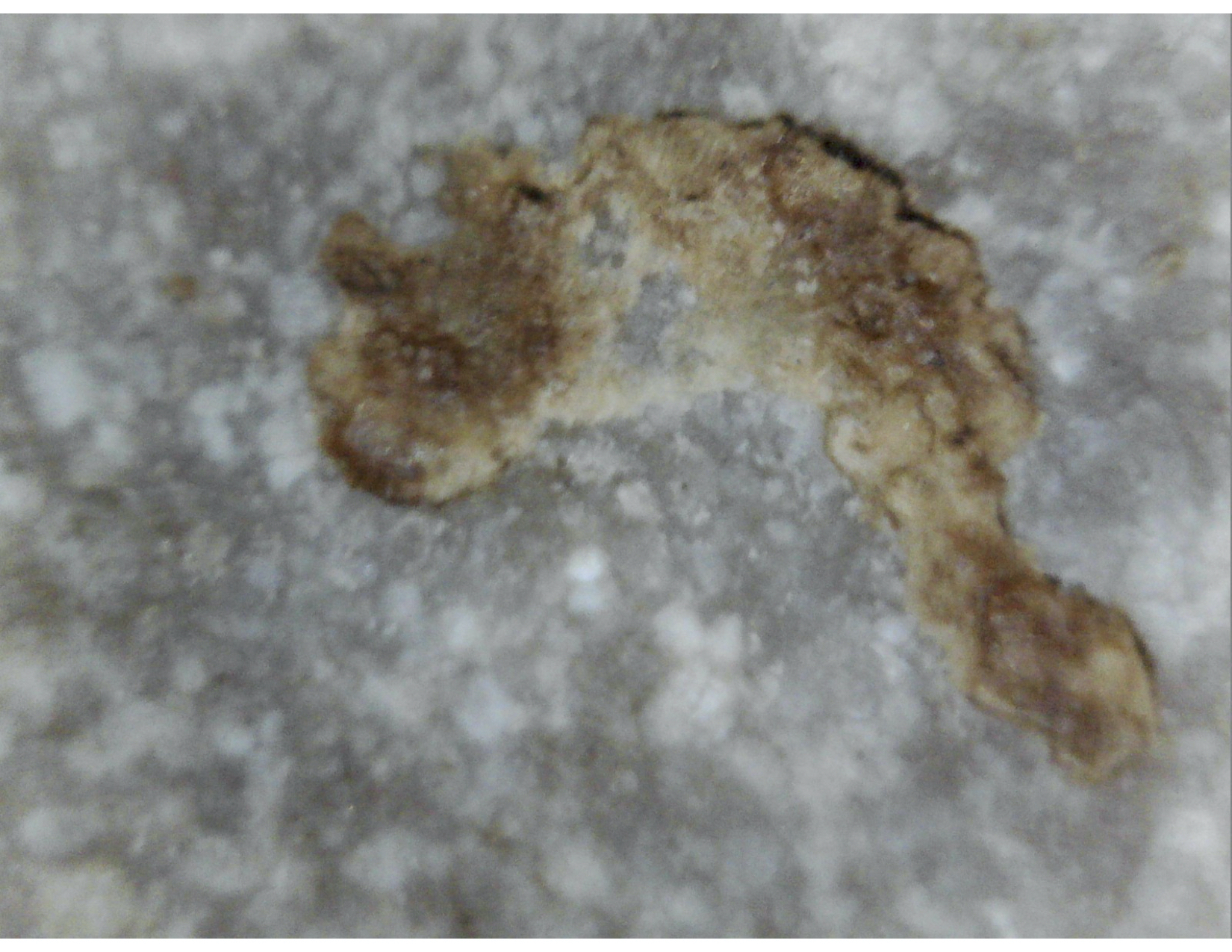
Above: Microphoto #4 Closeup view of iron particle dissolution.
At the same time, tiny particle-sized impurities mostly of Iron or Barium origin are caught up in the flow of aqueous silica and also begin to oxidize, dissolve and trickle across the artifact’s surface. (See microphotos #3-#5 )

Above: Microphoto #5 showing aqueous silica flow lines.

Above: Microphoto #6 showing flow lines on mature white patina.
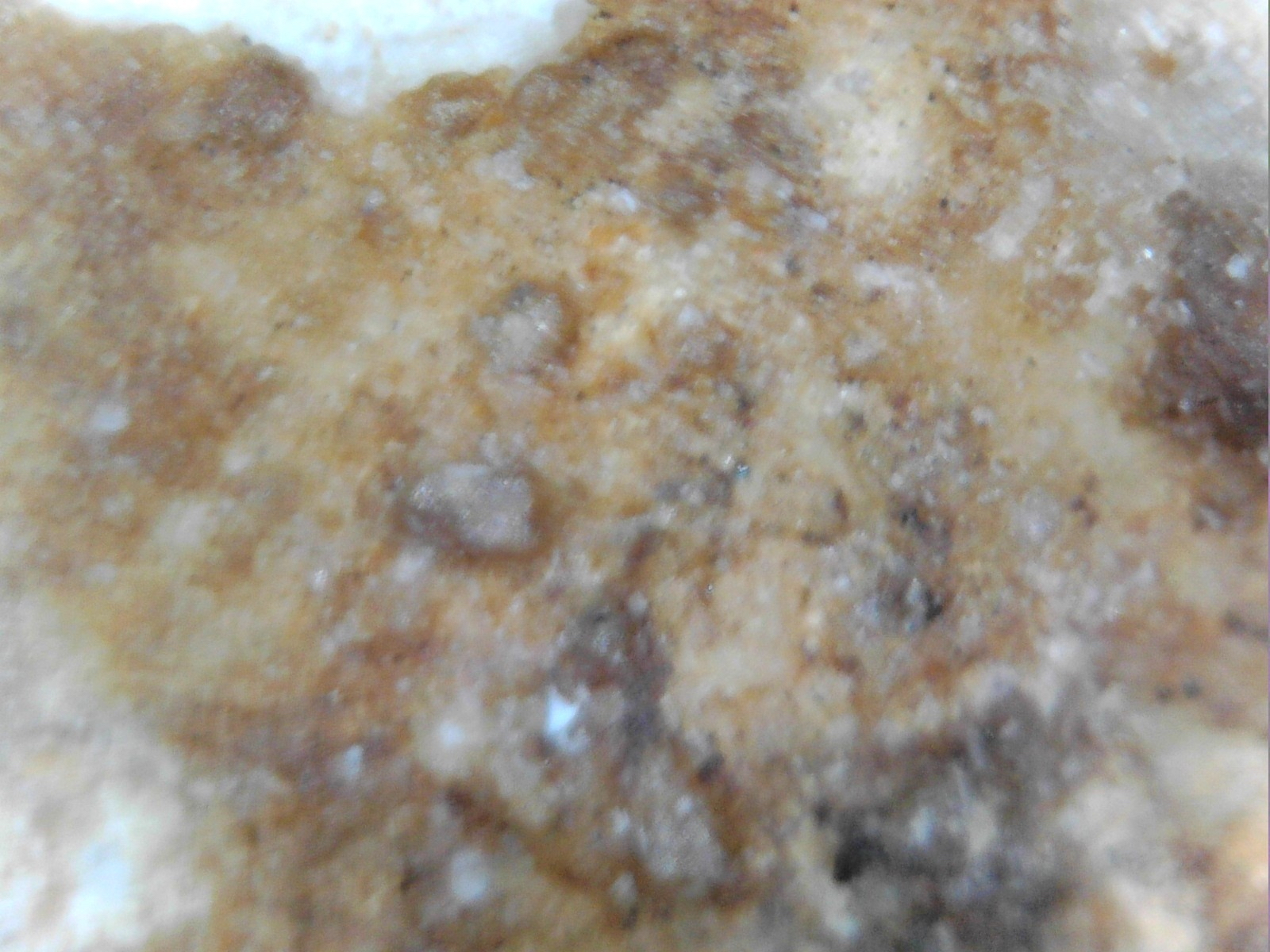
Above: Microphoto #7 showing mature brown-colored patina.
2025, Bingham, Robert B. A Close Look At Flint Patina. Texas Cache Magazine.
About the author: Robert Bingham is an avid avocational archaeologist who lives in Austin. All photos in this article courtesy of the author.
No part of this article may be reproduced without attribution to the following citation: 2025, Bingham, Robert B. A Close Look At Flint Patina. Texas Cache Magazine.
References
Reference 1- 1994, Frederick, Charles D. Frederick, Michael D. Glascock, Hector Nef and Christopher M. Stevenson. Evaluation of Chert Patination As a Dating Technique: A Case Study From Fort Hood, Texas by United States Army Fort Hood Archaeological Resource Management Series Report No. 32, p.5.
Reference 2- Also Evaluation of Chert Patination As a Dating Technique: A Case Study From Fort Hood, Texas p.5
Reference 3- 2022, Marine, Michel and Veerie, Rots. Into the light: The effect of UV light on flint tool surfaces, residues and adhesives. Journal of Archaeological Science: 6.4.1. Lithic Surface Modification
Reference 4-Schmaltz, Robert F. Flint and the Patination of Flint Artifacts by Cambridge University Press: 27 May 2014 (On-line Abstract)
Reference 5- also from Flint and the Patination of Flint Artifacts (On-line extract)
Reference 6 -2002, The Gloss Patination of Flint Artifacts Howard, Calvin D., Plains Anthropologist
Reference 7- also from Into the light: The effect of UV light on flint tool surfaces, residues and adhesives 6.3 Lithic Raw Material
Reference 8- also from Evaluation of Chert Patination As a Dating Technique: A Case Study From Fort Hood, Texas p.37
Reference 9- also from Evaluation of Chert Patination As a Dating Technique: A Case Study From Fort Hood, Texas p.3
Reference 10- also from Evaluation of Chert Patination As a Dating Technique: A Case Study From Fort Hood, Texas p.35
